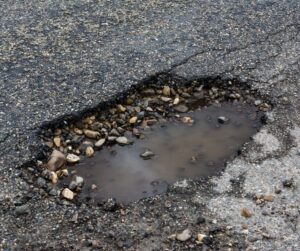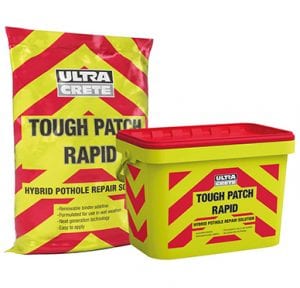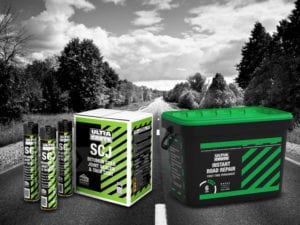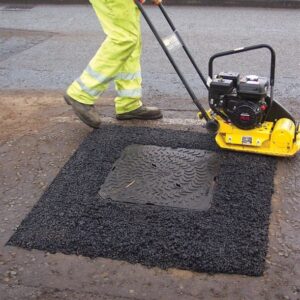Highway industry definitions
Highway industry contractors carrying out pothole repairs and manhole reinstatements use a wide variety of lingo. If you’re unsure of the meaning of a hardscape phrase or abbreviation, use this glossary to find the full definition.
Is there a term or abbreviation missing? This list is growing all the time. Get in touch if you have more road repair terms and definitions to add to the list.
Highway industry terms with definitions
Access point
The points of access to a sewer or drain for maintenance or inspection. This includes manholes, inspection chambers and rodding eyes.
AAV
Aggregate abrasion value (AAV) is the standard measure used to determine an aggregate’s resistance to abrasion.
Backfill
This is the material used to provide a solid structural base to receive the surface course material. Backfill material also holds the ironwork in place, which is already bedded onto a suitable bedding material.
Bedding mortar
Bedding mortars are the material used to fix the ironwork frame to the substrate.
Bond coat
Bond coats are proprietary materials that are PAS approved, generally formulated to enable heavier application rates than are possible with tack coats and to provide greater cohesion between bituminous layers.
UltraCrete’s Envirobed Flowable system (bedding mortar) has reduced defects on our network by 98%. Its simplistic application has also saved us time on site, improved productivity and reduced reinstatement costs.
Sammy Nelson, United Utilities Tweet
CBGM
This stands for cement bound granular material and was previously known in the UK as cement bound macadam (CBM).
CBGM is a mix of aggregate and binder that is set through hydraulic action. See HBM below for more details.
CBR
Californian bearing ratio. This is the measure of load bearing strength.
Clegg testing
A Clegg test uses a Clegg hammer to measure the compaction or hardness of a surface. Most contractors will Clegg test the subgrade to ensure they have achieved the right level of compaction.
Cold lay tarmac
Cold lay tarmacs allow you to patch potholes without a hot mastic mixer or pre-heating at a facility. Look for HAPAS approved cold-lay mixes for permanent repairs.
Composite construction
Some roads are composed of lean mix concrete or other cement bound granular material (CBGM). These composite constructions normally consist of bituminous surfacing layers.
Curtilage
A curtilage is an area of land around a building – or group of buildings – that is for the private use of the occupants of those buildings.
Cut-back
A cut-back is the term used when the width of the reinstatement of binder or surface course is wider than the reinstatement below. This strategy offers a higher resistance to water ingress.
Cycle track
A highway path or track where the public have right of way on a bicycle only.
Deep openings
A deep opening is classified as those excavations and trenches where the depth of cover over the apparatus is more than 1.5 metres.
DMRB
The Design Manual for Roads and Bridges. The DMRB manual consists of 15 volumes of standards, advice notes and other important documentation relating to the design, assessment and operation of roads, carriageways and motorways in the UK.
Drains
Classified as a pipeline, usually underground, which is designed to carry foul sewage from buildings within the same curtilage.
Emergency works
Works are classified as ‘emergency’ when they require immediate action. Emergency works are usually deemed to be dangerous to persons or property.
Flexible construction
When the base of a reinstatement is composed of either bituminous or granular materials – or a mixture of the two materials – it is classed as a flexible construction.
Footpath
A way over that the public has a right of way on foot only. A footpath is different to a footway (see below).
Footway
A highway, which also comprises a carriageway, where the public has a right of way on foot only. Different to a footpath (see above).
Any product that has HAPAS approval offers confidence and long-term proven durability. Here at Ultracrete, we’re proud to have had the HAPAS certification since 2005.
Dave Youell, UltraCrete Tweet
Geosynthetic materials
When components of a sheet or structure are made of synthetic or polymer, they are often referred to generically as geosynthetic materials. In civil engineering applications, these materials can be used in contact with soil and other materials
HAUC
The Highways Authorities and Utilities Committee (HAUC) is a representative body working with local highways authorities and utilities companies to improve how works are managed across the street and road network.
A road repair contractor or hardscape specialist will need to follow the local authority’s HAUC specificiation for the area they are working in.
HAUC specs will outline product requirements for like-for-like materials for road repairs, plus compaction charts for the various plant you have access to.
HAPAS
Commonly referred to as HAPAS, the Highway Authorities Product Approval Scheme is a product certification scheme for the highway industry in the UK.
The scheme enables products not covered by a standard to achieve third party product certification to provide evidence of performance and service life.
Find out more about HAPAS approved products for manhole reinstatements.
Hardscape
In landscaping, hardscape refers to the non-living parts of the landscaping project, such as paving, stone walls and driveways. All highway and road repairs are classed as hardscape projects.
HBM
HBM stands for hydraulically bound materials. It is the term used generically for a family of products including cement bound granular materials (see above).
HD
Highway Design is often abbreviated to HD in the industry. Highway Design is the standard within the Design Manual for Bridges and Roads (see above).
Hot lay tarmac
Hot mastic mixes are usually heated at a facility to get them to reach a high temperature before being shipped. Modified hot-lay tarmac is now available that can be heated on-site and doesn’t require the need of a compactor.
Cold-lay tarmac (see above) is a simple to use alternative to hot lay tarmac.
Obviously sourcing a hot, batched mix is not always feasible, so cold-lay packs of tarmac are superb for quick repairs. There are ‘off-the-shelf’ hot-lay tarmacs available now too, such as Enviro Mastic, that do the job well and don’t even need a mechanical plate compactor as it can be easily compressed using a hand tamp.
Dan Cloke, surfacing specialist Tweet
Immediate reinstatement
An immediate reinstatement is a term used for works that are finished immediately.
A cold-lay material (see above) is usually applied for immediate reinstatements, although a modified mastic asphalt is now available for hot-lay applications and can be heated on-site using a pre-heated mastic mixer.
Interim reinstatement
Sometimes reinstatements are filled with temporary materials until a permanent reinstatement can be carried out (see below).
Intervention
An intervention happens when a poor reinstatement needs to be restored. Often the performance standards have not been met.
Ironwork frames
Sometimes referred to as street furniture in the industry. Ironwork or ironwork frames usually apply to manhole covers, gully tops and chambers installed on a road surface.
LA
LA means the Los Angeles abrasion value in the highway industry. This is the measure of resistance to abrasion of an aggregate.
Lateral drain
The part of a drain that is outside the curtilage of the property it serves.
The list of causes to ironwork failure is in fact endless. The ironwork cover can sometimes sink within the frame. This can either be due to wear of the seating, or if the handscape contractor installed the incorrect class of manhole cover for that type of road.
Dave Youell, UltraCrete Tweet
Major projects
The main thing that deems a project as major is when the standard works have been identified and planned at least six months in advance before the work commences.
MCHW
MCHW stands for the Manual of Contract Documents for Highway Works. Volume 1 of this manual is the Specification for Highway Works (SHW). See below for more details.
Modular construction
Structures made up of setts, concrete blocks, brick pavers or paving slabs, which are all modular in design.
MSA
Stands for million standard axles. This is the number of commercial vehicles that are expected to be occupying the road at the end of its design life.
Narrow trenches
A trench is considered to be narrow when the surface width is 300mm less and it has a surface area greater than 2 metres.
Overbanding
The action of sealing narrow cracks or joints on a road surface to prevent water ingress and failure of the reinstatement. Bituminous or resin based sealants, such as Instaband Eco, can be applied hot or cold to seal joints usually less than 5mm wide. The maximum width is normally less than 40mm.
PAS approved
When a highway product is PAS approved it means an independent testing lab has tested, monitored and carried out quality checks to ensure the material complies to standards. PAS stands for the Product Acceptance Scheme.
Patchwork
A colloquial term used for ‘patching’ potholes on roads.
PCSMs
Permanent Cold Lay Surfacing Materials (PCSMs) are manufactured and laid at ambient temperatures, as opposed to hot-lay surfacing materials. PCSMs are used for reinstating around ironwork, utility trenches and filling potholes. They remain usable for several weeks after manufacture, allowing them to be delivered in small loads, tubs and bags and making them ideal hand lay reinstatements.
Also see cold lay tarmac above.
PEN
This refers to the penetration grade of a bituminous binder.
Permanent reinstatement
Pothole repairs that have been saw cut into a square, rectangle or diamond, and have properly compacted reinstatement layers up to – and including – the finished level.
Read a surfacing specialist’s trade secrets for permanent reinstatements.
Permitted
On occasions, an allowable alternative is ‘permitted’ to the preferred surfacing option.
PMMA
PMMA stands for polymer modified mastic asphalt. When the Mastic asphalt material is manufactured using a polymer modified binder, it imparts additional beneficial properties that improve its end performance and durability. An example is Enviro Mastic hot lay asphalt.
Preferred
When an option is preferred it is the favoured choice.
PSV
PSV stands for polished stone value. Maintaining the required PSV allows you to create a safe, robust reinstatement. The local authority will stipulate the PSV value for the existing surfacing.
In the UK, a high PSV above 68 is generally required.
PTV
The pendulum test value. PTV is the value derived when using the pendulum test to determine the friction available on a floor service and can be used to assess the slip potential.
The pendulum test has been recommended by the Health and Safety Executive and is the subject of a British Standard (BS 7976).
Maintaining the correct PSV (aka polished stone value) is essential for creating a safe and robust reinstatement for skid resistance, particularly for carriageways and turning circles for lorries. The best course of action is to contact your local authority and ask what material they stipulate to give you the PSV value of the existing surface course. High PSV is anything above 68. This is the national go to for us in the UK.
Dan Cloke, surfacing specialist Tweet
RAMS
A road repair contractor should have a Risk Assessment & Method Statement, otherwise known as a RAMS. Although having and working to your RAMS is not yet a legal requirement, the Health & Safety Executive may look on your company disfavourably if an accident happens and there was no RAMS in place.
Chapter 8 of your RAMS includes your risk assessment.
Reinstatement
The word reinstatement is commonly used in the highway industry when referring to a pothole repair job.
Rigid construction
A rigid construction usually consists of reinforced, pavement-quality concrete.
Road and footway structure
A road and footway structure includes the surface course, binder course, base and also the sub-base.
Sewer
A pipeline, usually underground, designed to carry foul sewage from buildings.
SHW
The Specification for Highway Works (SHW) was published by the Stationary Office as Volume 1 of the Manual Contract Documents for Highway Works (MCHW). SHW has been specifically developed for the Trunk Road Network, which is any road controlled by national highways on the strategic network.
Although SHW is a national spec document for highways works, it can be used as guidance. Once roads have been built and when reinstatements or maintenance is later required, local authorities can adapt the specification to suit their needs. Essentially, as long as the products that are used for reinstatements meet the criteria, they can be trialed on roads across the region.
Small excavations
When a surfacing contractor talks about small excavations they are referring to all openings with a surface area of 2m2 or less.
SROH
The Specification for the Reinstatement of Openings in Highways (SROH) is an important document by the Department for Transport that outlines the standards for reinstating roads. The latest fourth edition was published in May 2020.
SRV
The SRV stands for the skid resistance value of a reinstatement material. The higher the value, the more skid resistance a material provides.
Reinstatement materials with high SRVs are essential for surfaces that require more skid resistance, such as carriageways and turning circles for lorries.
Surface course
The surface course is the very last layer of road construction (excluding road markings). As the top layer, the surface course is the part of a road that endures direct contact with traffic.
Stepped joint
A stepped joint is best practice when repairing larger potholes. They help you to avoid creating deep, vertical joints that are more susceptible to water ingress, damage from traffic and ultimately pothole failure. .
Stepped joints usually contain a sub-grade at the bottom followed by a binder course and a wearing course at the top.
Read a surfacing specialist’s trade secrets to read more about stepped joint lifts.
Street
The word ‘street’ in hardscape terminology refers to any highway, road, lane, footway, alley or passage. It also refers to any square or court.
SWQR
Road repair and highway contractors can join the Street Works Qualifications Register (SWQR) to register their relevant qualifications and be issued with a SWQR ID card.
With a SWQR card, you can demonstrate to potential employers and clients that you have the correct background knowledge and can perform safely. Many local authorities look for evidence of a SWQR card during the tendering process.
The Street Works Qualifications Register is also a must to be able to perform safely with the correct background knowledge to undertake the task at hand. It is something that local authorities will look for during a tender process.
Dan Cloke, surfacing specialist Tweet
Tack coat
Applying a tack coat to the horizontal and vertical inside surfaces of an asphalt reinstatements is best practice. Tack coats such as a cold joint spray offer an incredibly strong adhesion for bituminous layers. They should be applied to each single layer for permanent reinstatements.
The Act
There are obviously many acts around. But when a surfacing contract refers to ‘The Act’ they are often referring to the New Roads and Street Works Act 1991, also known as NRSWA.
Trim-line
The trim-line is the cut surface that defines the outer edge of the reinstatement.
Trimback
When we say trimback we are referring to the area between trim-lines that is excavated around a fixed feature to allow an adequate reinstatement.
UKAS
The UK Accreditation Body (UKAS) is the national accreditation body that introduced a national scheme for accrediting laboratories to test the quality and reliability of materials.
Undertaker
Not to be confused with a funeral director, an undertaker in streetworks lingo is usually the holder of a streetworks licence. An undertaker is someone who has a statutory right to execute works.
Urgent works
Some works fall short of emergency works (see above) but they still require immediate action to prevent further deterioration of a situation. These types of works are called urgent works.
Wheel tracking
A wheel tracking test is used to determine the deformity of surface courses.
Contact us for road repair advice
If you have a burning question about repairing potholes, contact our team of experts on 0330 122 1025 (weekdays, 8.30am–5.30pm). As valued UltraCrete stockists, we’re here to help you make the best choice for your domestic or commercial project.

£8 Billion of Extra Funding to Repair England’s Roads
How the new local authority funding to fix our ravaged roads will be spent and the best practice resurfacing materials and techniques for permanent pothole repairs.

‘82% fewer pothole repairs’ with Tough Patch
Pothole repair crews at Kier, the UK’s leading construction and infrastructure services company, were concerned with the number of return visits they were doing to re-fix reinstatements. Find out what changes they made to their protocols and how Tough Patch cold-lay tarmac helped them achieve 82% fewer pothole repairs.

A complete guide to cold-lay tarmacs and ancillaries
Brush-up on the grades and options available for premixed pothole repair products and the recommended ancillary items in our complete guide to cold-lay tarmacs.

A cold weather guide to repairing potholes
During winter, a combination of rain and frost can create havoc for Britain’s roads in the form of potholes. But can you fix potholes during

Pothole repair 101: an essential guide for commercial contractors
If you’re in the business of resurfacing and landscaping then repairing potholes is likely to be your bread and butter. But no matter how much

Trade secrets for permanent pothole repairs from UK surfacing specialist
As a hardscape surfacing specialist and manager of the UK’s biggest civils and Tarmac social media group, Dan Cloke is no stranger to repairing potholes



